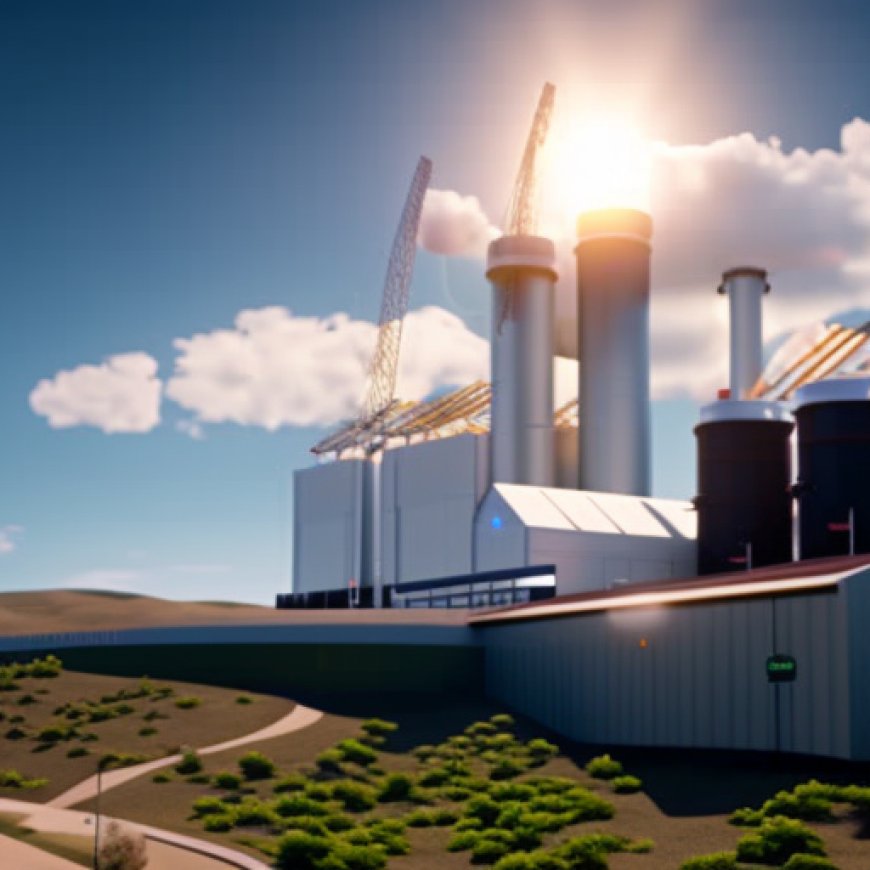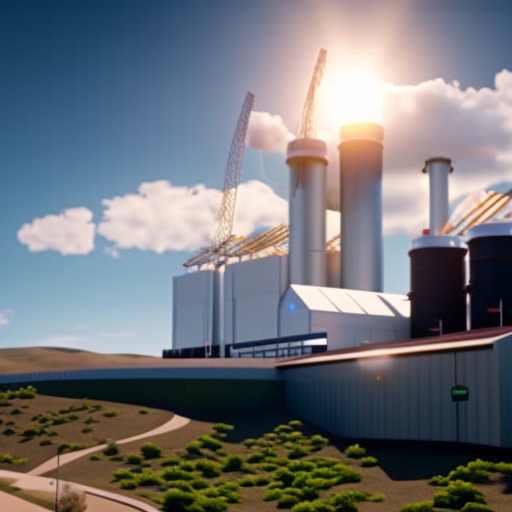Anaergia Selected to Design, Build and Operate Organic Waste-to-Renewable Energy Project in San Diego County
Anaergia Selected to Design, Build and Operate Organic Waste-to ... waste360


Anaergia Inc. Selected as Energy Recovery Contractor for East County Advanced Water Purification Facility

Anaergia Inc. (TSX: ANRG) has been chosen as the Energy Recovery Contractor for the East County Advanced Water Purification (East County AWP) facility in Santee, California. The facility, which is currently under construction, aims to produce renewable power from wastewater sludge. Anaergia plans to design and build the waste-to-renewable energy facility, as well as provide long-term operations and maintenance after commissioning.
About the East County AWP Facility
The East County AWP facility is part of the Advanced Water Purification Program, a partnership among Padre Dam Municipal Water District, the City of El Cajon, the County of San Diego, and Helix Water District. The program is expected to generate up to 11.5 million gallons per day of new local drinking water, which is enough to supply approximately 50,000 households for a year.
Renewable Power Generation
Anaergia’s project at the East County AWP facility will produce renewable power from biogas created by anaerobically digesting wastewater solids and potentially locally sourced organic waste. The project includes a waste-to-renewable power system with a biogas conditioning system, combined heat and power (CHP) generation, and an optional receiving station with storage tanks for organic waste deliveries. These technologies will enable the facility to generate up to 3.1 megawatts of renewable electricity and heat, with potential for future expansion to 4.6 megawatts.
- The project supports Sustainable Development Goal 7: Affordable and Clean Energy
- The project contributes to Sustainable Development Goal 9: Industry, Innovation, and Infrastructure
- The facility helps achieve Sustainable Development Goal 12: Responsible Consumption and Production
The integration of organic waste reception at the facility also aligns with California law, which requires the diversion of organic waste from landfills to reduce methane emissions.
Environmental and Economic Benefits
Brett Hodson, CEO of Anaergia, stated that the East County AWP facility serves as a model for other facilities by leveraging proven technology, adding resilient infrastructure, and bringing economic benefits to the utility. The project reduces dependence on electric utilities, cuts costs for municipalities, and contributes to environmental sustainability.
Mark Niemiec, Director of the East County AWP, highlighted that the Energy Recovery project maximizes the production, beneficial use, and value of biogas while delivering energy savings, infrastructure enhancements, and environmental and community benefits. The project reduces the facility’s use of fossil fuels, improves energy resiliency, and ultimately benefits ratepayers.
About Anaergia
Anaergia is a company dedicated to turning organic waste into renewable natural gas (RNG), fertilizer, and water using cost-effective proprietary technologies. With a proven track record on four continents, Anaergia provides end-to-end solutions for extracting organics from waste, implementing high-efficiency anaerobic digestion, upgrading biogas, producing fertilizer, and cleaning water. The company operates in the municipal solid waste, municipal wastewater, agriculture, and food processing industries.
For further information, please visit www.anaergia.com.
SDGs, Targets, and Indicators
1. Which SDGs are addressed or connected to the issues highlighted in the article?
- SDG 6: Clean Water and Sanitation
- SDG 7: Affordable and Clean Energy
- SDG 9: Industry, Innovation, and Infrastructure
- SDG 11: Sustainable Cities and Communities
- SDG 12: Responsible Consumption and Production
- SDG 13: Climate Action
The article discusses the construction of a new water purification facility that aims to produce renewable power from wastewater sludge. This connects to SDG 6, which focuses on clean water and sanitation. The project also involves the production of renewable power, aligning with SDG 7. Additionally, the integration of waste-to-renewable power systems and the reduction of methane emissions from landfills relate to SDGs 9, 11, 12, and 13.
2. What specific targets under those SDGs can be identified based on the article’s content?
- SDG 6.4: By 2030, substantially increase water-use efficiency across all sectors and ensure sustainable withdrawals and supply of freshwater to address water scarcity.
- SDG 7.2: By 2030, increase substantially the share of renewable energy in the global energy mix.
- SDG 9.4: By 2030, upgrade infrastructure and retrofit industries to make them sustainable, with increased resource-use efficiency and greater adoption of clean and environmentally sound technologies and industrial processes.
- SDG 11.6: By 2030, reduce the adverse per capita environmental impact of cities, including by paying special attention to air quality and municipal and other waste management.
- SDG 12.4: By 2020, achieve the environmentally sound management of chemicals and all wastes throughout their life cycle, in accordance with agreed international frameworks, and significantly reduce their release to air, water, and soil to minimize their adverse impacts on human health and the environment.
- SDG 13.2: Integrate climate change measures into national policies, strategies, and planning.
Based on the article’s content, the targets mentioned above can be identified. These targets focus on increasing water-use efficiency, promoting renewable energy, upgrading infrastructure, improving waste management, achieving environmentally sound waste management, and integrating climate change measures.
3. Are there any indicators mentioned or implied in the article that can be used to measure progress towards the identified targets?
- Indicator 6.4.1: Change in water-use efficiency over time
- Indicator 7.2.1: Renewable energy share in the total final energy consumption
- Indicator 9.4.1: CO2 emissions per unit of value added
- Indicator 11.6.1: Proportion of urban solid waste regularly collected and with adequate final discharge out of total urban solid waste generated
- Indicator 12.4.1: Number of parties to international multilateral environmental agreements on hazardous waste, including their compliance with the agreements
- Indicator 13.2.1: Number of countries that have communicated the establishment or operationalization of an integrated policy/strategy/plan which increases their ability to adapt to the adverse impacts of climate change, and foster climate resilience and low greenhouse gas emissions development in a manner that does not threaten food production
The article implies indicators that can be used to measure progress towards the identified targets. These indicators include changes in water-use efficiency, the share of renewable energy consumption, CO2 emissions per unit of value added, the proportion of urban solid waste properly managed, compliance with hazardous waste agreements, and the establishment of integrated policies/strategies/plans for climate change adaptation.
4. Table: SDGs, Targets, and Indicators
| SDGs | Targets | Indicators |
|---|---|---|
| SDG 6: Clean Water and Sanitation | 6.4: By 2030, substantially increase water-use efficiency across all sectors and ensure sustainable withdrawals and supply of freshwater to address water scarcity. | Indicator 6.4.1: Change in water-use efficiency over time |
| SDG 7: Affordable and Clean Energy | 7.2: By 2030, increase substantially the share of renewable energy in the global energy mix. | Indicator 7.2.1: Renewable energy share in the total final energy consumption |
| SDG 9: Industry, Innovation, and Infrastructure | 9.4: By 2030, upgrade infrastructure and retrofit industries to make them sustainable, with increased resource-use efficiency and greater adoption of clean and environmentally sound technologies and industrial processes. | Indicator 9.4.1: CO2 emissions per unit of value added |
| SDG 11: Sustainable Cities and Communities | 11.6: By 2030, reduce the adverse per capita environmental impact of cities, including by paying special attention to air quality and municipal and other waste management. | Indicator 11.6.1: Proportion of urban solid waste regularly collected and with adequate final discharge out of total urban solid waste generated |
| SDG 12: Responsible Consumption and Production | 12.4: By 2020, achieve the environmentally sound management of chemicals and all wastes throughout their life cycle, in accordance with agreed international frameworks, and significantly reduce their release to air, water, and soil to minimize their adverse impacts on human health and the environment. | Indicator 12.4.1: Number of parties to international multilateral environmental agreements on hazardous waste, including their compliance with the agreements |
| SDG 13: Climate Action | 13.2: Integrate climate change measures into national policies, strategies, and planning. | Indicator 13.2.1: Number of countries that have communicated the establishment or operationalization of an integrated policy/strategy/plan which increases their ability to adapt to the adverse impacts of climate change, and foster climate resilience and low greenhouse gas emissions development in a manner that does not
Behold! This splendid article springs forth from the wellspring of knowledge, shaped by a wondrous proprietary AI technology that delved into a vast ocean of data, illuminating the path towards the Sustainable Development Goals. Remember that all rights are reserved by SDG Investors LLC, empowering us to champion progress together. Source: waste360.com
Join us, as fellow seekers of change, on a transformative journey at https://sdgtalks.ai/welcome, where you can become a member and actively contribute to shaping a brighter future.
|








